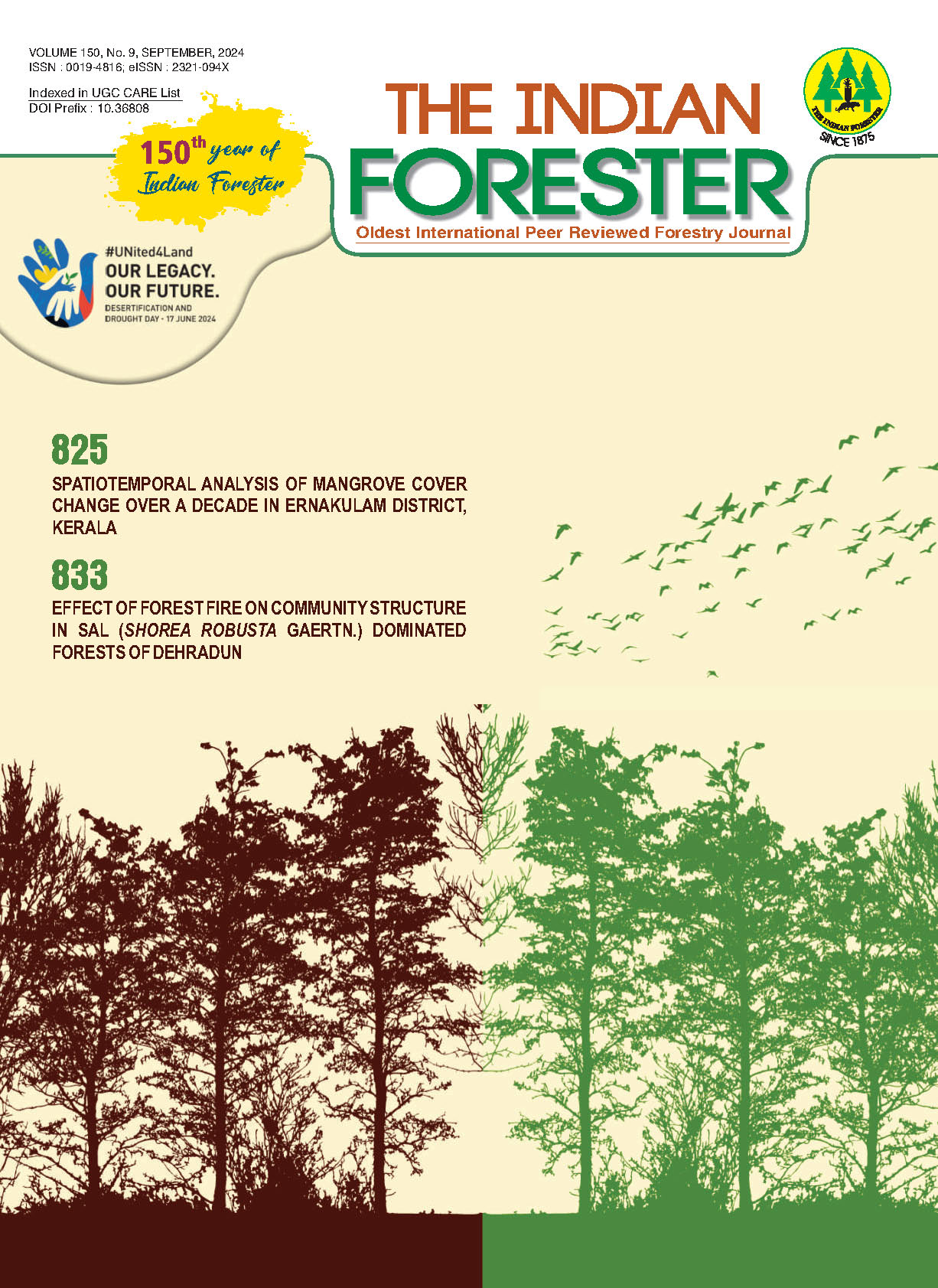Impact of Mining on the Floral Diversity: A Case Study from the Rajrappa Coal Mining Area of Jharkhand, India
DOI:
https://doi.org/10.36808/if/2024/v150i9/170580Keywords:
Ecological Assessment, Coal Mine, Floristic Diversity, Jharkhand, Species Density and Phytosociology.Abstract
The global challenge of safeguarding biodiversity is intensified by mining activities, necessitating prompt action from policymakers. Mining disrupts forest biodiversity, ecosystem services, and landscapes, making It difficult for species to thrive and regenerate. Although coal mining Is a source of government revenue, it results in extensive deforestation and soil degradation. The present investigation was carried out In the Rajrappa coal mining area in Ramgarh district of Jharkhand state. The floral survey was carried out by stratified random sampling. Five buffer zones were created at a distance of 1 km from the center of the mining area. Collected data were analyzed for density, richness. Total 132 anglosperm species (Trees: 39; Shrubs: 51 and Herbs: 42) were reported from 67 families and 42 genera from the study area. Species richness and total density was very low near the center of the mine while increases when It goes away from the mining area. Richness o f the species was ranged from 9-16. Density of trees and shrubs were ranged from 440-760 and 750-1200 Ind/ha. Total basal area was ranged from 65.81-80.16 m2ha-1. Density of herbs was ranged from 16-27 Ind/m2. The contagious dispersion tendency of species throughout the mining region suggests that natural vegetation degradation Is Increasing as a result of mining. The phytosociologicai Indices demonstrate the Impact in the forest structure and dynamics of the region. The study concludes that the subsequent analysis of ecological status and give the policymakers to formulate proper restoration plan and management practices to safeguard the forest biodiversity.References
Baig M.N. (1992). Natural revegetation of coal mine spoils In the rocky mountains of Alberta and significant for species selection in land restoration. Mountain Research and Development, 12(3): 285-300.
Biswas C.K., Mishra P. and Mukhetjee A. (2013). Floral diversity in sites deranged by opencast mining in Sonepur Bazari of Raniganj coalfield area, West Bengal. Journal of Applied and Pure Biology, 28(2): 265-273.
Buta M., Blaga G., Paulette L., Pacurar I., Rosea S., Borsai O., Grecu F., Sinziana RE. and Negrusier C. (2019). Soil reclamation of abandoned mine lands by revegetation in Northwestern part of Transylvania: A 40-Year retrospective study Sustainability, 11(12): p. 3393.
Curtis J.T. and McIntosh R.P. (1950). The interrelations of certain analytic and synthetic phytosociological characters. Ecology, 31 (3): 434-455.
Dhar U., Rawal R.S. and Samant S.S. (1997). Structural diversity and representativeness of forest vegetation in a protected area of Kumaun Himalaya, India: implications for conservation. Biodiversity and Conservation, 6:1045-1062.
Ekka N. and Behera N. (2011). Species composition and diversity of vegetation developing on an age series of coal mine spoil In an open cast coal field in Orissa, India. Trop. Ecol., 52: 337-343.
Futa A.C., Screenivasa V., Natarajan P. and Prabhadevi L. (2016). Impact of mining activity on soil quality and plant biodiversity In senkele farls, West Shoa Zone, Ethiopia. Journal of Natural Sciences Research, 6(3): 1-7.
Goswami S. (2015). Impact of coal mining on environment. European Researcher, 3:185-196.
Hapsari L., Trimanto T. and Budiharta S. (2020). Spontaneous plant recolonization on reclaimed post-coal mining sites in East Kalimantan, Indonesia: Native versus alien and succession progress. Biodiversitas Journal of Biological Diversity, 21(5): 2003-2008.
Hazarlka R, Talukdar N.C. and Singh Y.R (2006). Natural colonization of plant species on coal mine spoils at Tikak Colliery, Assam. Tropical Ecology, 47(1): 37-46.
Komara L.L., Choesin D.N. and Syamsudin T.S. (2016). Plant diversity after sixteen years post coal mining in East Kalimantan, Indonesia. Biodlversitas Journal of Biological Diversity, 17(2): 231-238.
Kundu N.K. and Ghose M.K. (1997). Soil profile Characteristic In Rajmahal Coalfield area. Ind. J. Soil Water Conserv., 25: 28-32.
Li Z.W., Yang Z.F., Zhu J.J., Hu J., Wang YJ., Li P.X. and Chen G.L. (2015). Retrieving three-dimensional displacement fields of mining areas from a single InSAR pair. Journal of Geodesy, 89:17-32.
Mondal S., Pallt D. and Chattopadhyay P. (2020). Impact of mining on tree diversity of the coal mining forest area at Raniganj coal field area of West Bengal, India. Eco Env Cons., 26:66-72.
Moreno-JImenez E., Pefiaiosa J.M., Manzano R., CarpenaRuiz R.O., Gamarra R. and Esteban E. (2009). Heavy metals distribution in soils surrounding an abandoned mine in NW Madrid (Spain) and their transference to wild flora. Journal of Hazardous Materials, 162(2-3): 854-859.
Mueller-Dombois D. and Ellenberg H. (1974). Vegetation types: a consideration of available methods and their suitability for various purposes.
Novianti V., Choesin D.N., Iskandar D.T. and Suprayogo D. (2017). Plant species from coal mine overburden dumping site In Satui, South Kalimantan, Indonesia. Journal of Degraded and Mining Lands Management, 4(4): 927-936.
Sarma K. (2005). Impact of coal mining on vegetation: A case study in Jaintia Hills district of Meghalaya, India . PhD thesis Indian Institute of Remote Sensing, National Remote Sensing Agency (Nrsa), Department of Space, Dehradun, India. Pp. 76.
Shannon C.E. and Weaver W. (1963). The mathematical theory of communication. Urbana-Champaign, IL: University of Illinois Press.
Sheoran V., Sheoran A.S. and Poonia P. (2010). Soil Reclamation of abandoned mine land by revegetation: a review. Int. J. Soil Sediment Water, 3-13.
Sonter L.J., All S.H. and Watson J.E. (2018). Mining and biodiversity: key issues and research needs in conservation science. Proceedings of the Royal Society S., 285(1892): 20181926.
Washington D.C. Chukwu M., Folayan C.O., Pam G.Y and Obada D.O. (2016). Characterization of Some Nigerian Coals for Power Generation. J. Combust., 01-11.
Yusuf M. and Arisoesilaningsih E. (2017). Exotic plant species attack revegetation plants in post-coal mining areas. In AIP Conference Proceedings(Vol. 1908, No. 1). AIP Publishing.
Zou C., Zhao Q., Zhang G. and Xiong B. (2016). Energy revolution: from a fossil energy era to a new energy era. Nat. Gas Ind., 3:1-11. doi: 10.1016/j.ngib.2016.02.001
Downloads
Downloads
Published
How to Cite
Issue
Section
License
Unless otherwise stated, copyright or similar rights in all materials presented on the site, including graphical images, are owned by Indian Forester.





